
Preservation Self-Assessment Program
Daguerreotypes, Ambrotypes, and Tintypes
These direct image formats are unique, developed directly onto support material with no separate negative. Daguerreotypes and ambrotypes are often enclosed in a hinged case behind glass; tintypes were sometimes placed in thin folding cases.
- Daguerreotype (1839 - 1860s)
- Tintype (c. 1853 - 1930s)
- Ambrotype (c. 1854 - 1880s)
Support Materials
Daguerreotype
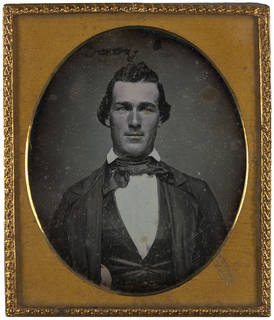

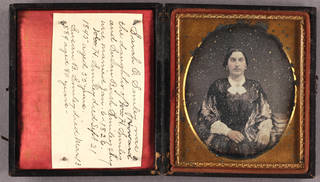
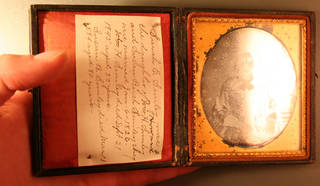
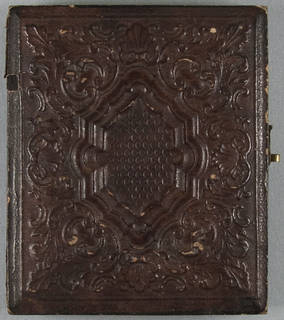
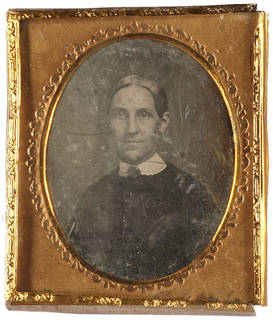
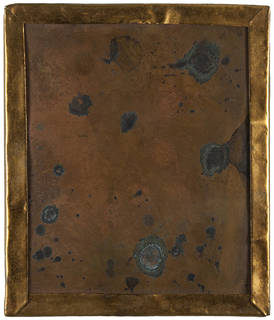
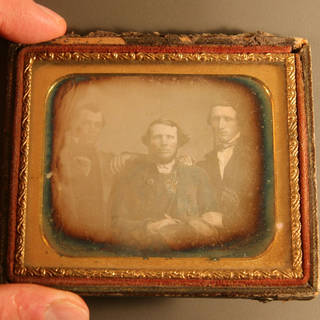
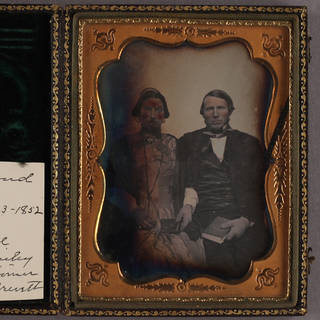
- Dates
- 1839 – 1860s
- Surface Sheen
- Highly polished, mirror-like silver
- Image Tone
- Monochrome (the color varies by light source and angle but is often cool); subtle hand-coloring common
- Description
- A daguerreotype is a direct positive process with a silver-coated copper plate support and a silver-mercury amalgam image. Image highlight areas are composed of silver-mercury, while dark areas remain silver metal. Daguerreotypes are easily identified by a mirror-like, highly polished silver surface and its dually negative/positive appearance when viewed from different angles or in raking light. Daguerreotypes are typically housed in miniature hinged cases made of wood covered with leather, paper, cloth, or mother of pearl. The image may sometimes exhibit subtle dry pigment hand-coloring.
- Composition
-
Support Image Silver-plated copper Silver-mercury amalgam - Deterioration
- The daguerreotype contains the most fragile of all sensitized photo image layers. It is highly susceptible to tarnishing and abrasion, since the image material exists only on the outer surface of the plate. Daguerreotypes should remain enclosed in their original cases or packages to protect the plate’s surface from mechanical damage and atmospheric pollutants. Tarnishing will result from opening the case packaging or sealer; it will begin as a light brown that progresses toward blue-black opaque staining along the the outer edge. Old cover glasses may also show signs of deterioration in the form of small white spots on the inside surface of the glass. Daguerreotypes should never be exposed to intense light.
- Risk Level
- Moderately high. Care should be taken to protect the object from abrasion, light, atmospheric pollutants, and high humidity. Never remove a daguerreotype from its case before consulting a photo conservator. Careful handling must also be a priority due to the fragility of the cover glass.
- Common Size(s)
- The sixth-plate is the most popular size, measuring 2¾" × 3¼" . Additional sizes include the full plate: 6½" × 8½" ; half-plate: 4¼" × 5½" ; quarter-plate: 3¼" × 4¼" ; ninth-plate: 2" × 2½" ; Sixteenth-plate: 1⅜" × 1⅝" .
- Background
- Daguerreotypes were produced from 1839 to the 1860s. The process was developed by Louis-Jacques Mandé Daguerre, who discovered how to fix images produced by cameras obscura. Daguerreotypes became a popular means of portraiture, especially by the late 1840s when exposure times were reduced to only a few seconds. Daguerreotypes were usurped by ambrotypes in the 1850s because they were faster and cheaper to produce.
- Storage Environment
-
Allowable Fluctuation: ±2°F; ±5% RH
Temp. 40–68°F (4–20°C) RH 30–40% RH - Storage Enclosure(s)
- Do not attempt to remove a daguerreotype from its original case/package before consulting a trained conservator. Secondary acid-free box enclosure is advised; fortify the cased daguerreotype by wrapping it in acid-free tissue. All storage materials should pass the Photographic Activity Test (PAT) as specified in ISO Standard 18916:2007.
- Storage Orientation
- Store vertically with dividers between each slide. May also be stored horizontally (flat). Enclosures and folders may be stored in hanging files or archival storage boxes. Wood cabinets should be avoided. Enameled steel, stainless steel, or anodized aluminum are preferred.
- Display Recommendations
-
Original daguerreotypes of value/significance should never be displayed for any long period of time. Consider the use of facsimiles instead. The duration of an exhibit should be determined in advance, and no item should be placed on display permanently. Most items should not be displayed for longer than 3 to 4 months, assuming other conditions such as light levels, temperature, and relative humidity are within acceptable ranges. Facsimiles or items of low artifactual value may be exhibited for longer periods of time. Between display periods it should be returned to an appropriate environment where it may "rest" in dark storage.
Light levels should be kept as low as possible. When on display, objects should be protected from exposure to natural light, which contains high levels of UV radiation. Shades, curtains, or filters applied directly to windows will help to minimize this exposure. This is particularly important for daguerreotypes, which are very sensitive to light. Display cases should be enclosed and sealed to protect their contents, and their items should be securely framed or matted using preservation-quality materials that have passed the Photographic Activity Test (ISO18916).
For more information on exhibition management, see Exhibition Guidelines.
Tintype
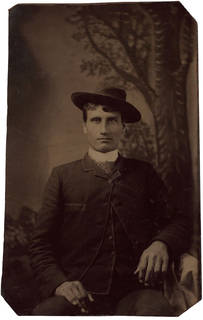
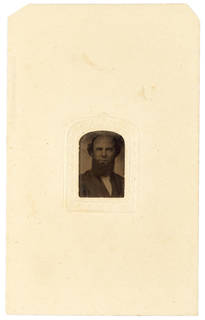
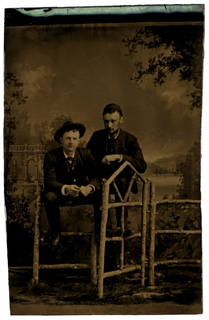
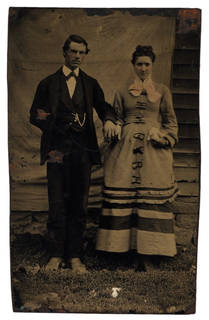
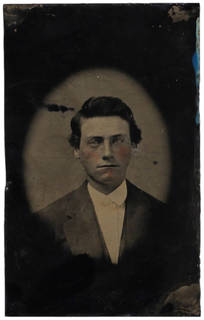
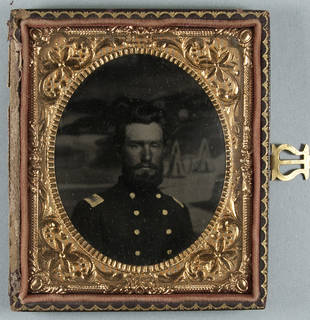
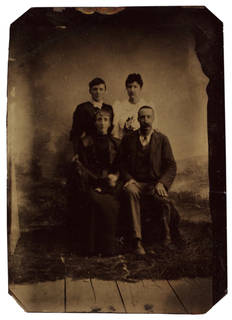

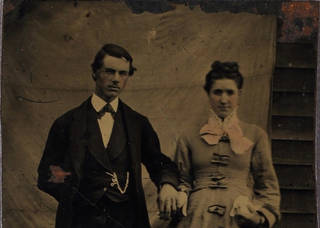
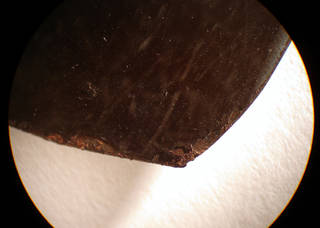
- Synonyms
-
- Ferrotype
- Melainotype
- Melanograph
- Dates
- c. 1853 – 1930s
- Surface Sheen
- Semi-glossy
- Image Tone
- Monochrome (chocolate brown to sepia; milky-white highlights); subtle hand-coloring common
- Description
- A tintype is a direct positive with a lacquered iron support, collodion binder layer, and silver image layer. Tintypes are most commonly found in the carte-de-visite size (approx. 2 ½" × 4" to 4 ¼" ), although they were also produced in smaller sizes. Most tintypes can be thought of as an underexposed image having low contrast and limited tonal range. The varnished (with black/brown paint, lacquer, or enamel) iron support shows through in dark areas, where silver image particles are few. The image is basically a silver negative set against this background, bringing out highlights comprised of silver particle concentrations that appear milky-white. Tintypes were occasionally placed in small hinged cases but were more typically inserted into folding cards or envelopes/window mats made of paper or metal; today they will mostly be loose. Cased tintypes may be difficult to distinguish from cased ambrotypes. Weight can help to differentiate, but a magnet may be used to conclusively identify the tintype's iron support.
- Composition
-
Support Binder Image Iron Collodion Silver - Deterioration
- The most significant preservation risk to tintypes is exposure to water and high humidity, which will lead to oxidation and rusting. This in turn will cause blistering, flaking, and total loss of the image emulsion layer. If placed on a secondary paper support or in a sleeve, rust stains may show on its back side. A tintype found today will likely be found loose and is often therefore dented, bent, or scratched up. The collodion binder and varnishes are sensitive to light; they will yellow and delaminate under intense light exposure.
- Risk Level
- Moderate. Tintypes should not be displayed under strong light. They should be stored in envelopes with a piece of archival cardboard inside to prevent deformation and mechanical damage.
- Common Size(s)
- Varied, sizes listed are approximations. The sixth-plate (or "bon-ton") is the most common, measuring about 2½" × 3½". A quarter-plate is roughly 3¼" × 4¼". Gem tintypes are 1½" × 1½" or smaller. Additional sizes include the ninth-plate (2" × 2½"), half-plate (4½" × 5½"), and whole-plate (6½" × 8½").
- Background
- Tintypes were commonly produced from 1853 to the 1930s. They are made using a process similar to the ambrotype but feature a lacquered iron support in place of glass with an opaque backing. Owing to their material resilience and ease of processing, tintypes superseded ambrotypes in the most corners, yet they were still considered lower class photography. Tintypes were often in use by photographers producing fast, cheap portraits on the street or at public fairs. Tintypes are most associated with the American Civil War as they were at their most popular during this time and were used to document its battle sites and soldiers.
- Storage Environment
-
Allowable Fluctuation: ±2°F; ±5% RH
Temp. 40–68°F (4–20°C) RH 30–40% RH - Storage Enclosure(s)
-
Acid-free enclosures and/or folders strongly advised. Each tintype should have its own enclosure to protect it from dust, handling damage, and changes in environmental conditions. Tintypes with flaking emulsions should be stored flat and stored in low-humidity. Tintypes in good condition are best stored in a sturdy four-flap enclosure if loose or, if cased, wrapped in acid-free tissue and placed in a folding box to prevent breakage and abrasion.
- Storage Orientation
- Store vertically with dividers between each slide. May also be stored horizontally (flat). Enclosures and folders may be stored in hanging files or archival storage boxes. Wood cabinets should be avoided. Enameled steel, stainless steel, or anodized aluminum are preferred.
- Display Recommendations
-
The duration of an exhibit should be determined in advance, and no item should be placed on display permanently. Most items should not be displayed for longer than 3 to 4 months, assuming other conditions such as light levels, temperature, and relative humidity are within acceptable ranges. Facsimiles or items of low artifactual value may be exhibited for longer periods of time. Between display periods, it should be returned to an appropriate environment where it may "rest" in dark storage.
Light levels should be kept as low as possible. When on display, objects should be protected from exposure to natural light, which contains high levels of UV radiation. Shades, curtains, or filters applied directly to windows will help to minimize this exposure. This is particularly important for tintypes, which are very sensitive to light. Display cases should be enclosed and sealed to protect their contents, and their items should be securely framed or matted using preservation-quality materials that have passed the Photographic Activity Test (ISO18916).
For more information on exhibition management, see Exhibition Guidelines.
Ambrotype
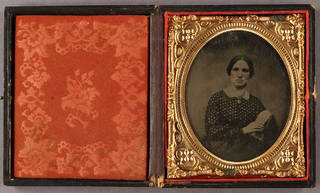
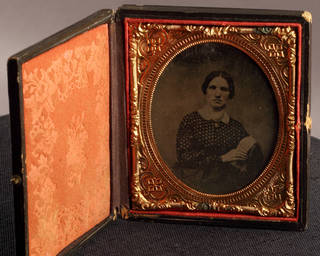
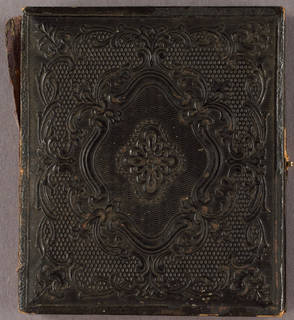
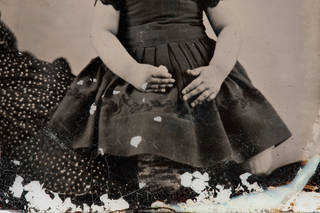
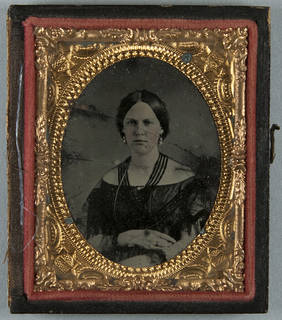
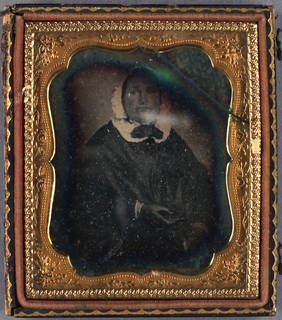
- Synonyms
-
- Collodion positive
- Wet-collodion positive
- Dates
- c. 1854 – 1880s
- Surface Sheen
- Glossy, often behind glass
- Image Tone
- Monochrome (chocolate brown to warm gray-black; milky-white highlights); subtle hand-coloring common
- Description
- An ambrotype is a direct imaging process with a glass support, collodion binder, and silver image. Ambrotypes are backed with a dark opaque material (e.g. black lacquer, velvet), which makes their negative image appear positive: dark areas appear so because the backing material shows through clear areas in the glass. Highlights of the image are comprised of silver particle deposits and will appear milky-white. Image contrast is low; tonal range is limited. Glass thickness can add a sense of depth to the image. The image may sometimes be slightly hand-colored. Like daguerreotypes, ambrotypes are almost exclusively portraiture. They are typically housed in miniature hinged cases made of wood covered with leather, paper, cloth, or mother of pearl.
- Composition
-
Support Binder Image Glass Collodion Silver - Deterioration
-
Ambrotypes may display cracks and, in advanced stages, flaking in what appears to be the image. However, this is actually the dark varnish used to coat the back of the image emulsion on one side of the glass. As the varnish falls away, it reveals the negative image. This decay may be caused by a number of issues, but often high humidity and temperature spur this along.
Due to their glass support, ambrotypes can sustain severe damage through breakage. The image surface should never be touched; and, similar to daguerreotypes, ambrotypes should remain in their cases or sealed packages to protect them from abrasion and pollutants. If the image surface is not varnished, the silver image may become oxidized by exposure to air.
- Risk Level
- Moderately high. Care should be taken to protect the object from abrasion, light, pollutants, and humidity. Careful handling and storage must also be a priority due to the fragility of its glass support and casing.
- Common Size(s)
- Varied, but were often were sized to fit daguerreotype cases. The sixth-plate is the most popular size, measuring 2¾" × 3¼" . Additional sizes include the full plate: 6½" × 8½" ; half-plate: 4¼" × 5½" ; quarter-plate: 3¼" × 4¼" ; ninth-plate: 2" × 2½" ; and the sixteenth-plate: 1⅜" × 1⅝" .
- Background
- Ambrotypes were produced from about 1854 to the 1880s. The process was also known as a collodion positive in Britain but was popularized under the name "ambrotype." The resulting image of the process involves applying an opaque, dark backing to a glass plate negative so the image appears positive. Ambrotypes were a popular means of portraiture. They were an economical alternative to daguerreotypes but were largely replaced by tintypes, which were even cheaper, faster, and easier.
- Storage Environment
-
Allowable Fluctuation: ±2°F; ±5% RH
Temp. 40–68°F (4–20°C) RH 30–40% RH - Storage Enclosure(s)
- Acid-free enclosures and/or folders strongly advised. Each ambrotype should have its own enclosure to protect it from dust, handling damage, and changes in environmental conditions. Ambrotypes in good condition are best stored in an acid-free four-flap enclosure or, if cased, wrapped in acid-free tissue inside a folding box to prevent breakage and abrasion. Ambrotypes with flaking emulsion layers should be stored flat. If in a paper sleeve or envelope, position emulsion side away from seams in the enclosures. Such seams (if any) should be on the sides of the enclosure, not down its center. All storage materials should pass the Photographic Activity Test (PAT) as specified in ISO Standard 18916:2007.
- Storage Orientation
- Store vertically with dividers between each slide. May also be stored horizontally (flat). Enclosures and folders may be stored in hanging files or archival storage boxes. Wood cabinets should be avoided. Enameled steel, stainless steel, or anodized aluminum are preferred.
- Display Recommendations
-
The duration of an exhibit should be determined in advance, and no item should be placed on display permanently. Most items should not be displayed for longer than 3 to 4 months, assuming other conditions such as light levels, temperature, and relative humidity are within acceptable ranges. Facsimiles or items of low artifactual value may be exhibited for longer periods of time. Between display periods, it should be returned to an appropriate environment where it may "rest" in dark storage.
Light levels should be kept as low as possible. When on display, objects should be protected from exposure to natural light, which contains high levels of UV radiation. Shades, curtains, or filters applied directly to windows will help to minimize this exposure. This is particularly important for ambrotypes, which are very sensitive to light. Display cases should be enclosed and sealed to protect their contents, and their items should be securely framed or matted using preservation-quality materials that have passed the Photographic Activity Test (ISO18916).
For more information on exhibition management, see Exhibition Guidelines.
Support Materials
Silver-plated copper
Daguerreotypes are often misidentified as tintypes due to the fact that they are framed behind glass and the copper support is often concealed by the polished silver sheet. The copper plate is heavy and usually about 0.4 mm thick, while the silver is about 0.01 mm. The image is extremely fragile, but the metal support does not factor into this vulnerability.
Glass
Glass is a transparent support material used for light-sensitive image materials, including the ambrotype. In general, glass is a very chemically stable support material. However, any glass plate is vulnerable to severe breakage and cracking. It has been reported that mild degradation of a glass support may be caused by prolonged exposure to high humidity, resulting in a hazy appearance. Extreme shifts in temperature could also cause glass to crack.
Lacquered iron
A lacquered/varnished iron sheet is the primary support material for the tintype, not tin as the format's name suggests. A magnet can easily identify the support. Iron corrosion is the main contributor to tintype deterioration. A humid environment can cause the iron support to rust, which causes the lacquer and overlying emulsion to blister and flake. The iron sheet itself is often very thin (~0.15 mm) in order to accommodate placement in albums and card displays; when handling a tintype, one should be careful not to bend or scratch either side.
Resources
- Hendriks, K. B., et al. (1991). Fundamentals of photograph conservation: A Study Guide. Toronto, ON, Canada: Lugus.
- ISO. (2007). 18916 Imaging materials: Processed imaging materials–Photographic activity test for enclosure materials. Geneva, Switzerland: International Organization for Standardization.
- For additional resources, see Photographic / Image Materials.